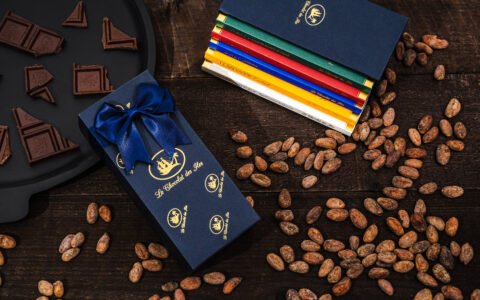
EL SALVADOR’S BEST-TASTING COCOA BEANS: THE CACAHUATL COOPERATIVE OF SAN PEDRO NONUALCO
Photo shows the owner of Le Chocolat Des Iles (middle) and some members of COOPERATIVA CACAHUATL
We had a quest to look for small cooperatives that produce the best-tasting cocoa beans. COOPERATIVA CACAHUATL de R.L. is the one that we selected from ten other cooperatives in El Salvador. The chocolate we made from its beans impressed us with its complexity of flavors.
The Cacahuatl Cooprative Of San Pedro Nonualco
There are 16 members in the Cacahuatl Cooperative Of San Pedro Nonualco, seven of them women.
Also, its name struck a chord! The word cacao comes from Cacahuatl in Nahuatl, the Lingua Franca of the Aztec Empire.
Cocoa bean (Theobroma cacao) trees have been an integral part of the flora of Mesoamerica from times immemorial. The members of this cooperative are following in the footsteps of their ancestors in cultivating the cacao plant. Notwithstanding the ancient traditions, we also noticed that they follow the precepts of modern post-harvest processing. This offers a high-quality and best-tasting cocoa product to the fine chocolate industry.
This group of farmers came together to constitute themselves into a cooperative on November 10, 2018. They produce cocoa beans based on respect for the environment and following a sustainable production system. The cooperative stresses that at no time during the whole production process, there is use of any chemicals.
The “fincas” or small holdings of this cooperative have a unique mix of Criollo, Trinitario, and Forastero with a sprinkling of “fino de aroma” cocoa trees. This very particular mix gives such a very flavorful chocolate that we had to include it in our collection.
Another criterion that led to the choice of this cooperative was its location. The surrounding area is pristine and all post-harvest processing is done in a remote location. The best cocoa beans are grown and processed in such areas. There are no foreign elements that can disrupt the aroma of cocoa beans during processing.
The members also impressed us with the care they take throughout the post-harvest process. Starting from the wet bean coming from the cocoa pods, to when they deposit them in wooden boxes of Spanish elm to start the fermentation process.
The fermenting beans need to turn every day for five to seven days before they are spread on the drying tables. Additionally, it is important to turn them for half an hour every day until they reach the required level of dryness. Once the beans are well–dried they are ready to sort and export, as they produce some of the best chocolates.
/*54745756836*/


